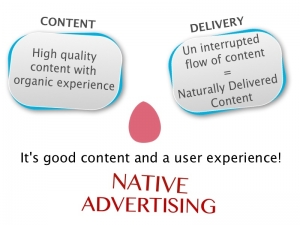is there actually any substance behind the term "native advertising", or is native advertising just the latest buzzword in an industry that specializes in creating buzzwords?
The answer: It depends on who you talk to. Native advertising appears to mean different things to different people.
First, some etymology: "Native advertising" appears to have come from a talk that investor Fred Wilson gave at OMMA Global last September. Wilson didn't use the term "native advertising," but he did mention "native monetization" for web properties, which he described as ads that were "unique and native to the experience" of the site. Dan Greenberg, the CEO of Sharethrough, liked the idea and began promoting it.
But what is it? When asked for a definition, Greenberg offered, "a form of media that’s built into the actual visual design and where the ads are part of the content." While Greenberg draws a distinction between native advertising and content marketing, John LoGioco, SVP and general manager of content at Outbrain, says the two are pretty much the same. "'Native advertising' seems to be the thing that most are able to hang on to and get it," he says. "If people understand better, that's great."
Deep Focus CEO Ian Schafer, considers native advertising in this case just a re-packaged version of advertorials, a timeworn ad format for print media. Schafer's definition is a bit different: "Advertising that takes advantage of a platform in the ways consumers are actually using it." For Schafer, that means something like Facebook's Sponsored Stories, which merely amplifies the communication that's going on between fans and brands or Premium Ads that let a brand pay to blast fans with a recent status update. Twitter's Promoted Tweets don't fit the bill because that's merely an intrusive banner ad by another name, but Promoted Accounts works because consumers can choose to follow and interact with the account.
Despite the back and forth, though, Greenberg doesn't see much of a difference of opinion. For him, all the activity falls under one broad umbrella. "We're using different words, but we're all dancing around the same definition," he says. "It's good content and a user experience that's consistent."
This story first appeared on mashable.com
geoeng
What Is 'Native Advertising'?

17 September, 2013


















